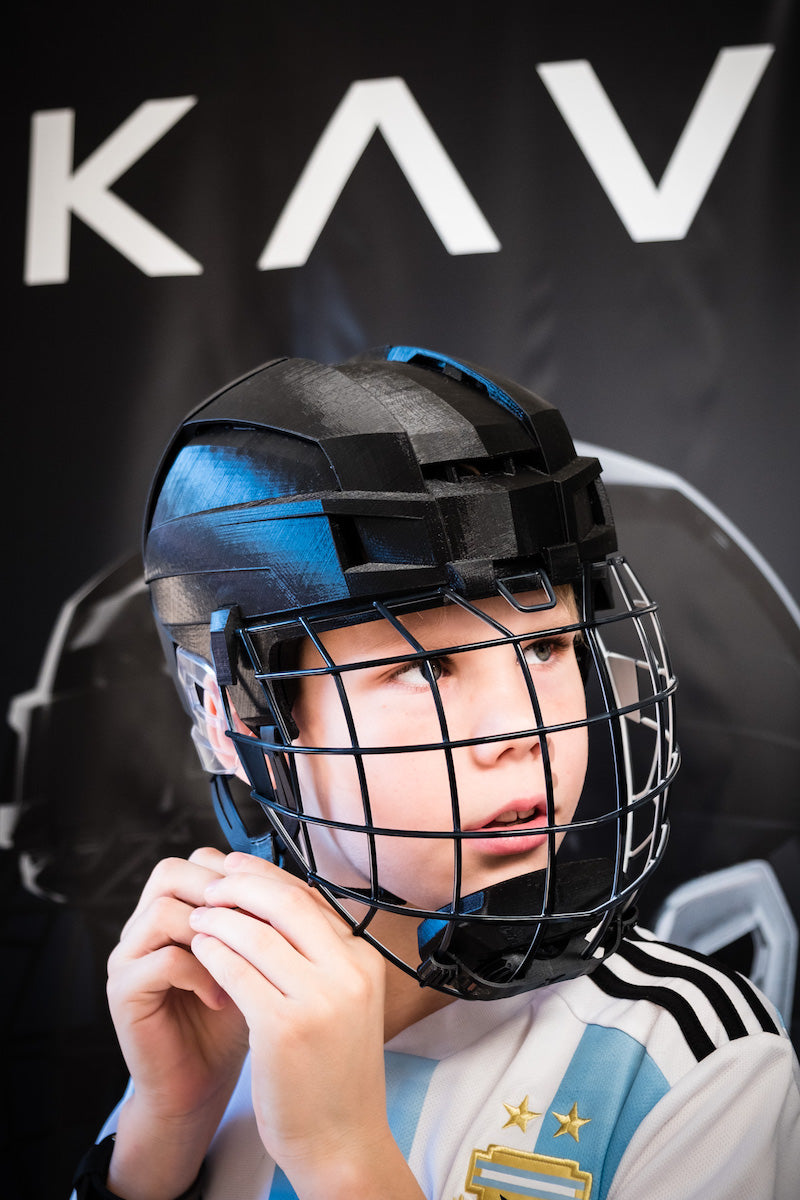
Despite technical advancements in everything from electric vehicles to smartphones, why are helmets still based on closed-cell foams and injection molded plastics? The extensive use of foam constrains the protective possibilities, and expensive tooling limits the number of available helmet sizes.
KAV was born with a mission of uncompromising safety, to protect not only the kids of the founders but athletes at every level of competition. Since 2015, a team of Silicon Valley engineers and designers have harnessed advanced materials, machine learning algorithms, and additive manufacturing to create a new paradigm in protective equipment. KAV fabricates custom-fit helmets with uncompromising performance as a natural byproduct.
 3d printing enables KAV to improve the protective characteristics of the helmet itself in three ways. First, by eliminating extraneous hardware, ratcheting mechanisms, and collapsing the ubiquitous two shell design for hockey helmets, the KAV helmet has more space for energy-absorbing materials in the same envelope. The result is a sleek helmet that passes the mirror test with flying colors. Second, 3d printed allows the creation of novel, energy-absorbing mechanical structures that obsoletes the use of foam. The geometry of these structures varies by location to optimize for different impact scenarios. Yet, they all work together for the singular purpose of reducing the linear and angular accelerations to the brain that current science correlates to traumatic brain injuries (TBI) or concussions. Finally, following the familiar axiom of the safest helmet is the one that fits, we reimagined what defines a custom-fit helmet.
3d printing enables KAV to improve the protective characteristics of the helmet itself in three ways. First, by eliminating extraneous hardware, ratcheting mechanisms, and collapsing the ubiquitous two shell design for hockey helmets, the KAV helmet has more space for energy-absorbing materials in the same envelope. The result is a sleek helmet that passes the mirror test with flying colors. Second, 3d printed allows the creation of novel, energy-absorbing mechanical structures that obsoletes the use of foam. The geometry of these structures varies by location to optimize for different impact scenarios. Yet, they all work together for the singular purpose of reducing the linear and angular accelerations to the brain that current science correlates to traumatic brain injuries (TBI) or concussions. Finally, following the familiar axiom of the safest helmet is the one that fits, we reimagined what defines a custom-fit helmet.
Like other sports, hockey helmets are available in a finite number of sizes. Why is it that an essential part of our body has a coarser sizing standard than shoes, shirts, pants, or even accessories like belts and socks? Acquiring a helmet that neither creates pressure points nor wobbles during play is a challenge. Manufacturers rely on various compromises such as ratcheting mechanisms or the insertion of fit pads to take up excess space. These mechanisms compromise safety either by displacing energy-absorbing materials, providing gaps in protection, or oversizing helmets to avoid pressure points. Hockey is unique in its frequent use of a 2- piece shell that telescopes out to accommodate different head lengths. Unfortunately, extending the helmet also creates massive gaps in energy-absorbing materials where the two pieces of shell separate from one another.
To fully capitalize on additive manufacturing, KAV fabricates a helmet around the athlete's unique measurements to produce the most comfortable form-fitting helmet. By building from the inside out, rather than having a rigid shell and shoehorning your noggin in, KAV offers the slimmest helmet possible. So while the safest helmet is the one that fits best, it turns out that with KAV, it also looks superior too.
The challenge with 3d printing is the inherent trade-off between durability, surface finish, and cost. The first two characteristics are non-negotiable in hockey. 100mph slapshots and getting checked by football sized defensemen are all part of the game. 3d printing enables the inception of a helmet with a monocoque structure to minimize weight, providing consistent performance.
 KAV turned to the MakerGear for a robust solution to make helmets to enable mass customization without compromising performance. The MakerGear M3 printers are workhorses, frequently operating 24/7 in a production environment. The fabricated components are fantastic and durable enough to exceed all the certifications required for a rigorous sport like hockey. And like the KAV helmet, the M3s are manufactured in the USA. So it's no surprise that the world's most advanced helmet depends on the best FDM printer on the market. With KAV and Makergear, a new paradigm of manufacturing is born: mass customization enabling unrivaled performance in helmets. Visit www.kavsports.com for additional information.
KAV turned to the MakerGear for a robust solution to make helmets to enable mass customization without compromising performance. The MakerGear M3 printers are workhorses, frequently operating 24/7 in a production environment. The fabricated components are fantastic and durable enough to exceed all the certifications required for a rigorous sport like hockey. And like the KAV helmet, the M3s are manufactured in the USA. So it's no surprise that the world's most advanced helmet depends on the best FDM printer on the market. With KAV and Makergear, a new paradigm of manufacturing is born: mass customization enabling unrivaled performance in helmets. Visit www.kavsports.com for additional information.